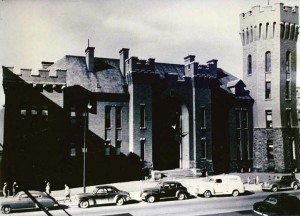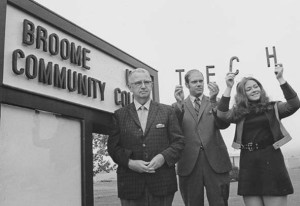SUNY Broome Community College traces its roots back to the end of World War II, when veterans began returning home and sought greater educational opportunities. In 1946, the state legislature agreed to establish five institutes of arts and sciences – in Binghamton, Buffalo, Utica, White Plans and New York City – for an experimental five-year period.

Under the direction of Cecil C. Tyrrell, the Institute of Applied Arts and Sciences opened a year later in the State Armory downtown, with the first class graduating in 1949. Of the first 215 students, 63 were World War II veterans. Plans to turn the institute into a two-year community college took shape in 1950, when then-Gov. Thomas Dewey approved a master plan for developing the state’s education facilities.
Disaster struck in the early morning hours of Labor Day in 1951. The Armory was destroyed in what was then the worst property damage fire in the city’s history. Despite the massive loss, college officials were determined to rise from the ashes.
“We’ll never have a better opportunity to plan for the campus that we all know we’ll need someday,” Director Tyrrell told his fellow administrators while surveying the smoldering ruins. “We’ll start planning tomorrow morning.”
In a show of support, other colleges sent trucks labeled “Bundles for Binghamton,” bearing books and other materials to help the college rebuild. Exactly one month later, the college reopened in the Kalurah Temple next door and offered classes in several downtown sites.
Renamed the Broome County Technical Institute, the institution became an official community college in 1953, when the Broome County Board of Supervisors voted to accept the Community College Plan. A year later, the county’s planning board considered more than 20 sites for the college’s new home, ultimately choosing the former County Poor Farm on Upper Front Street in Dickinson — making the community college the first in the SUNY system to undertake the construction of a completely new campus.
The first building on campus, now known as the Student Services Building, opened for electrical students in 1956, the same year the college changed its name yet again to Broome Technical Community College. The campus’ first five buildings were completed in March 1957, and the campus hosted its first on-site graduation the next year.
Paul F. Titchener Hall opened in 1961 and eventually became home to the college’s Liberal Arts program, established in 1962 to award the associate in arts degree – and make it possible for students to complete the first two years of their bachelor’s degree. This initiative paved the way in 1973 for a joint degree program between the college and SUNY Binghamton – now known as Binghamton University – and the nearly 30 articulation agreements with four-year schools the college offers today.

Campus development continued in the decades to come: A new library, later named after Tyrrell, opened in 1968, followed by construction of the Business Building in 1971 – the same year the college’s name changed again, this time to Broome Community College. The Applied Technology Building began to take shape in 1984, followed by a new Campus Services Building in 1992 and the state-of-the-art Decker Health Science Center in 1998 — the latter home to the largest health science division in all of SUNY’s community colleges.
The college developed in other ways, as well. One was sports, which entered the national athletics spotlight in 1961, when the Hornets’ basketball game against New York City Tech became the first junior college game televised in the country. In 1980, Coach Dick Baldwin broke the record for the most career victories ever by a two-year basketball coach, and become the “winningest” active college coach at either two- or four-year schools seven years later.
Another focus, true to the college’s roots, was technology. The college entered the computer age with a computer programming course in 1960, followed by its first computer – a punchcard-using IBM 1620 – in 1963.
Today, SUNY Broome offers multiple online courses, allowing students to complete a degree without setting foot in a campus classroom. While online courses began in the late 1990s, the college began offering off-campus courses in the late 1970s and 1980s via the technology of the day: local newspapers and videocassettes.
The college also adopted a more global outlook, opening its doors to international students. Almost 130 international students spent the year in 1982. Today, the college hosts students from Central America, the Caribbean and Mexico as part of its Scholarship for Education and Economic Development (SEED) Program, and offers online courses for international students. In 2012, nearly 200 students from abroad took classes.
The college also developed programs to broaden the geographic horizons of local students. By 1991, students were enrolled in courses offered in the Everglades, the Caribbean, Africa, Australia and Europe. Today, they can study abroad in Italy, Ecuador, Dominican Republic, Haiti and London – or stay closer to home, with satellite classrooms in their own communities.
While the college plays a crucial role in training workers for employment, it has continued to develop its top-notch academic programs and reach out to different populations. By the end of the 1980s, high school students were able to complete their first year of college — while they were still enrolled in high school. Those efforts continue today with a variety of programs, including the Pipeline Initiative that K-12 schools with SUNY Broome, Binghamton University and local industry. In a program that launches in Fall 2014, academically gifted high school students will be able to earn an associate in arts degree in a single year, allowing them to save both time and money before transferring to a top-flight university.
The college continues to evolve – often dramatically. In September 2013, it underwent its final name change to SUNY Broome Community College, highlighting its long history as a State University of New York institution.
That fall also marked a return to the college’s technical and scientific roots, and the increasing importance of science, technology, engineering and math (STEM) education with the opening of the $21 million Natural Science Center, which brings all of the college’s science courses into a single building with high-tech laboratories and classrooms.
The campus’ core buildings are also experiencing a rebirth. Extensive renovations have transformed the Darwin R. Wales Center – one of the first buildings constructed on campus – into a modern space in 2014, and plans are underway to similarly transform the rest of the original campus. The college also will return to its roots in downtown Binghamton, where it will transform the historic Carnegie Library into the SUNY Broome Hospitality Center, training students for future careers in the hospitality industry.
Opening in Fall 2014, the Student Village marks another major step: for the first time, SUNY Broome will be a residential campus. The $18 million project will house 336 students and help create a new student culture on campus, all while keeping the college competitive with other institutions.
While housing represents a new direction for the campus, this concept, too, has come full circle: the seeds were sown decades ago by the college’s visionary first president, Cecil C. Tyrrell. His 1969 master plan proposed expanding the campus with multiple new buildings — and student dormitories.
The dynamism of this 67-year-old college is rooted in its understanding that it is always “a work in progress” shaped by succeeding generations of faculty and administrators, who are always looking to serve the needs of current and future students and the community.